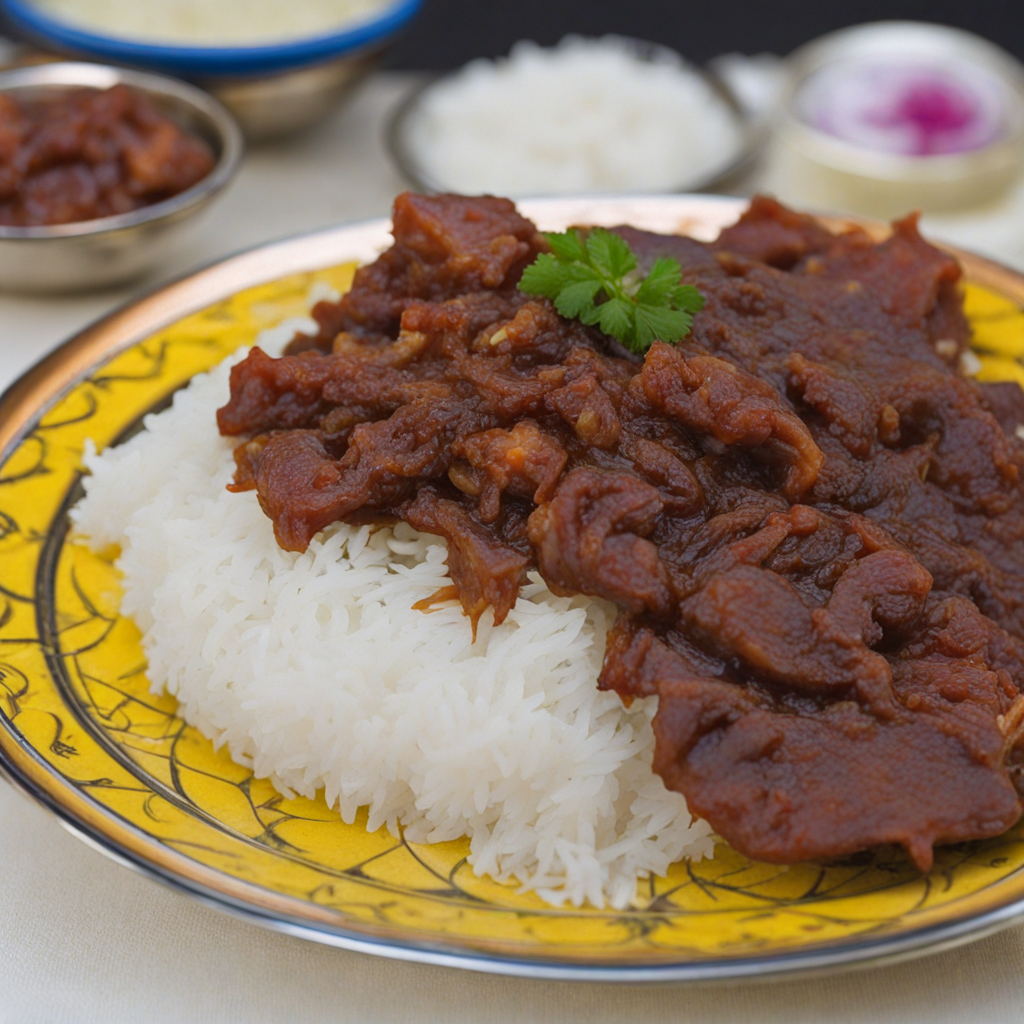Thamar Hindi
Thamar Hindi, a delightful culinary gem from Djibouti, captivates the senses with its unique blend of flavors and textures. This dish is primarily made from ripe tamarind, which lends a tangy sweetness that is both refreshing and invigorating. The tamarind is often combined with a variety of spices, including cumin and coriander, which enhance its natural tartness while providing a warm, aromatic backdrop. The addition of fresh herbs like cilantro or mint further elevates the dish, creating a vibrant contrast that dances on the palate. One of the most intriguing aspects of Thamar Hindi is its versatility. It can be served as a sauce, a dip, or even a marinade, making it a perfect accompaniment to grilled meats, vegetables, or flatbreads. The dish often showcases the rich agricultural bounty of Djibouti, incorporating local ingredients such as tomatoes, onions, and chili peppers, which add depth and complexity to the flavor profile. When paired with traditional Djiboutian dishes like injera or lentil stews, Thamar Hindi transforms a simple meal into a culinary adventure that reflects the region's rich cultural heritage. Whether enjoyed at a bustling street market or in the comfort of a home-cooked meal, Thamar Hindi offers an authentic taste of Djibouti’s vibrant food scene. The combination of sweet, sour, and spicy elements creates a harmonious balance that invites exploration and experimentation. For those seeking to expand their culinary horizons, Thamar Hindi is not just a dish but an experience that embodies the warmth and hospitality of Djiboutian culture, making it a must-try for adventurous food lovers.
How It Became This Dish
The Rich History of تمر هندي (Tamarind) in Djibouti: A Culinary Journey Tamarind, known locally as "تمر هندي" (tamr hindi), is a fruit with a rich history and deep cultural significance in Djibouti, a small but strategically located nation in the Horn of Africa. The journey of tamarind from its ancient origins to its contemporary use in Djiboutian cuisine reflects not only the evolution of food but also the intricate tapestry of trade, culture, and identity that defines this region. #### Origins of Tamarind Tamarind is native to tropical Africa, and its name derives from the Arabic "tamr hindī," which translates to "Indian date," reflecting its introduction to the Arabian Peninsula and subsequently to the Indian subcontinent. The tamarind tree (Tamarindus indica) has been cultivated for thousands of years, with evidence suggesting its use in ancient Egyptian and Indian civilizations. It was revered for its medicinal properties and culinary versatility, becoming a staple in various cuisines around the world. As trade routes expanded, particularly during the medieval period, tamarind found its way to the Arabian Peninsula and the East African coast, including Djibouti. The Swahili Coast, with its bustling ports and multicultural exchanges, facilitated the introduction of tamarind to local communities, where it quickly became integrated into the culinary practices of the region. #### Cultural Significance in Djibouti In Djibouti, tamarind holds a special place not only as a food item but also as a symbol of social gatherings and cultural heritage. It is often used to prepare a traditional drink called "bissap," which is enjoyed during festivals, weddings, and communal celebrations. Tamarind’s tangy flavor complements the sweetness of sugar and spices, creating a refreshing beverage that captures the essence of Djiboutian hospitality. Moreover, tamarind is often associated with the concept of "baraka," or blessings, in Djiboutian culture. The fruit is believed to possess protective qualities, and its consumption is thought to bring good fortune and health to families. This cultural significance extends beyond mere consumption; it is woven into the fabric of social interactions, where sharing tamarind-based dishes and drinks fosters community bonds. #### Culinary Uses and Preparation Tamarind's versatility is one of its most appealing attributes. In Djibouti, it is used in various forms: fresh, dried, or as a paste. The pulp, which is the edible part of the tamarind pod, can be extracted and used in numerous dishes, showcasing its adaptability across different culinary contexts. One popular dish is "sambusa," a savory pastry often filled with spiced meat or vegetables. Tamarind is sometimes incorporated into the filling or served as a tangy dipping sauce, enhancing the flavors and providing a delightful contrast to the rich fillings. Additionally, tamarind is a key ingredient in several stews and sauces, where its acidity balances the richness of meats and complements the spices commonly used in Djiboutian cuisine. In the realm of beverages, tamarind juice is a beloved refreshment, particularly during the hot months. The process of making tamarind juice involves soaking the tamarind pulp in water, straining it, and then sweetening it with sugar and flavoring with spices like ginger or mint. This drink is not only refreshing but also serves as a natural remedy for digestive issues, further underscoring the fruit's health benefits that have been recognized for centuries. #### Evolution Over Time The introduction of tamarind to Djibouti coincided with various historical events, including the rise and fall of empires, colonialism, and the globalization of food. During the 19th and 20th centuries, Djibouti became a hub for trade between the Middle East and Africa, and tamarind was among the many goods that were exchanged. This period saw an increase in the accessibility of tamarind, as it became a common ingredient in households, regardless of socio-economic status. With the advent of globalization in the late 20th and early 21st centuries, Djibouti's culinary landscape began to change. While traditional dishes remained central to the culture, the influx of international cuisines introduced new flavors and cooking techniques. However, tamarind has retained its cultural significance and continues to be celebrated in both traditional and contemporary dishes. Today, tamarind is not only a cherished ingredient in Djiboutian kitchens but also a symbol of resilience and adaptation. It represents the enduring connection between past and present, as well as the ability of traditional foods to evolve while maintaining their cultural roots. Modern chefs are experimenting with tamarind in innovative ways, incorporating it into fusion cuisine, desserts, and gourmet dishes, thus ensuring that this ancient fruit remains relevant in the ever-changing culinary world. #### Conclusion The history of tamarind in Djibouti is a captivating journey that transcends geography and time. From its ancient origins in Africa to its establishment as a staple in Djiboutian cuisine, tamarind has woven itself into the cultural fabric of the nation. Its culinary versatility, coupled with its cultural significance, makes it more than just a fruit; it is a symbol of community, tradition, and resilience. As Djibouti continues to navigate the complexities of modernity, tamarind stands as a testament to the power of food to connect people, preserve heritage, and adapt to new contexts. Whether enjoyed as a tangy drink during a festive gathering or as a key ingredient in a beloved dish, tamarind remains a cherished element of Djiboutian life, embodying the spirit and flavors of a diverse and vibrant culture.
You may like
Discover local flavors from Djibouti







